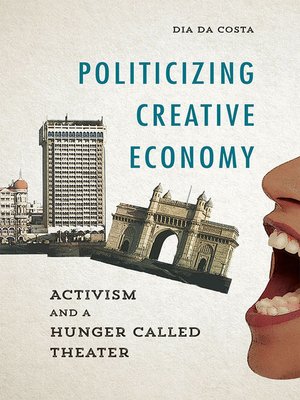Politicizing Creative Economy
ebook ∣ Activism and a Hunger Called Theater · Dissident Feminisms
By Dia Da Costa

Sign up to save your library
With an OverDrive account, you can save your favorite libraries for at-a-glance information about availability. Find out more about OverDrive accounts.
Find this title in Libby, the library reading app by OverDrive.



Search for a digital library with this title
Title found at these libraries:
| Library Name | Distance |
|---|---|
| Loading... |
Scholars increasingly view the arts, creativity, and the creative economy as engines for regenerating global citizenship, renewing decayed local economies, and nurturing a new type of all-inclusive politics. Dia Da Costa delves into the global development, nationalist and leftist/progressive histories shaping these ideas with a critical ethnography of two activist performance groups in India: the Communist-affiliated Jana Natya Manch, and Budhan Theatre, a community-based group of the indigenous Chhara people.
As Da Costa shows, commodification, heritage, and management discussions inevitably creep into performance. Yet the ability of performance to undermine such subtle invasions make activist theater a crucial site for considering what counts as creativity in the cultural politics of creative economy. Da Costa explores the precarious lives, livelihoods, and ideologies at the intersection of heritage projects, planning discourse, and activist performance. By analyzing the creators, performers, and activists involved—individuals at the margins of creative economy as well as society—Da Costa builds a provocative argument. Their creative economy practices may survive, challenge, and even reinforce the economies of death, displacement, and divisiveness used by the urban poor to survive.
| Title Contents Preface and Acknowledgments Introduction Part I: Politicizing Creative Economy 1. When Victims Become Entrepreneurs: From Sentimental Nationalism to Sentimental Capitalism 2. Ordinary Violence and Creative Economy Part II: Janam's Ideology for Life 3. An Ideology for Life? 4. Virtually Speechless 5. Laughing at the Enemy Part III: Budhan Theatre's Creative Economy 6. A Hunger Called Theater 7. The Good Women of Chharanagar 8. Another Creative Economy? Conclusion Notes Works Cited Index | Fills a gap in terms of uncovering the history of contemporary groups and locating their political work in the contexts of intersecting issues of class, caste, gender, and political power play. Importantly, it also carefully exposes the political conditions under which groups such as Janam and Budhan operate and the limitations and possibilities of their operations. Situating the work of the above-mentioned groups in the context of developmental discourses and within global networks of power (especially the role of UN organizations in defining 'creativity' and its implications for local contexts within India) adds an extremely important dimension to the work.—Nandi Bhatia, author of Performing Women/Performing Womanhood: Theatre, Politics, and Dissent in North India
"An ambitious book. . . . offering both a critical analysis of the sentiment of optimism that so frequently surrounds the creative economy and a sympathetic critique of the compromised opportunities that this discourse allows for marginal and oppositional cultural groups in postcolonial India."—Geraldine Pratt, author of Families Apart: Migrant Mothers and the Conflicts of Labor and Love
|Dia Da Costa is an associate professor of educational policy studies at the University of Alberta and the author of Development Dramas: Reimagining Rural Political Action in Eastern India.
As Da Costa shows, commodification, heritage, and management discussions inevitably creep into performance. Yet the ability of performance to undermine such subtle invasions make activist theater a crucial site for considering what counts as creativity in the cultural politics of creative economy. Da Costa explores the precarious lives, livelihoods, and ideologies at the intersection of heritage projects, planning discourse, and activist performance. By analyzing the creators, performers, and activists involved—individuals at the margins of creative economy as well as society—Da Costa builds a provocative argument. Their creative economy practices may survive, challenge, and even reinforce the economies of death, displacement, and divisiveness used by the urban poor to survive.
| Title Contents Preface and Acknowledgments Introduction Part I: Politicizing Creative Economy 1. When Victims Become Entrepreneurs: From Sentimental Nationalism to Sentimental Capitalism 2. Ordinary Violence and Creative Economy Part II: Janam's Ideology for Life 3. An Ideology for Life? 4. Virtually Speechless 5. Laughing at the Enemy Part III: Budhan Theatre's Creative Economy 6. A Hunger Called Theater 7. The Good Women of Chharanagar 8. Another Creative Economy? Conclusion Notes Works Cited Index | Fills a gap in terms of uncovering the history of contemporary groups and locating their political work in the contexts of intersecting issues of class, caste, gender, and political power play. Importantly, it also carefully exposes the political conditions under which groups such as Janam and Budhan operate and the limitations and possibilities of their operations. Situating the work of the above-mentioned groups in the context of developmental discourses and within global networks of power (especially the role of UN organizations in defining 'creativity' and its implications for local contexts within India) adds an extremely important dimension to the work.—Nandi Bhatia, author of Performing Women/Performing Womanhood: Theatre, Politics, and Dissent in North India
"An ambitious book. . . . offering both a critical analysis of the sentiment of optimism that so frequently surrounds the creative economy and a sympathetic critique of the compromised opportunities that this discourse allows for marginal and oppositional cultural groups in postcolonial India."—Geraldine Pratt, author of Families Apart: Migrant Mothers and the Conflicts of Labor and Love
|Dia Da Costa is an associate professor of educational policy studies at the University of Alberta and the author of Development Dramas: Reimagining Rural Political Action in Eastern India.







